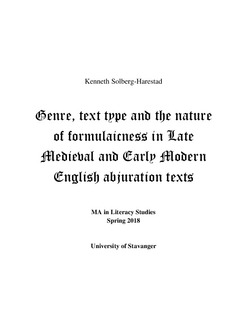| dc.contributor.advisor | Stenroos, Merja Riitta | |
| dc.contributor.author | Solberg-Harestad, Kenneth | |
| dc.coverage.spatial | England | nb_NO |
| dc.date.accessioned | 2018-07-04T10:51:08Z | |
| dc.date.available | 2018-07-04T10:51:08Z | |
| dc.date.issued | 2018-05-11 | |
| dc.identifier.uri | http://hdl.handle.net/11250/2504322 | |
| dc.description | Master's thesis in Literacy Studies | nb_NO |
| dc.description.abstract | Abstract
The thesis identifies the core genre and text type characteristics present in a corpus of 30 late fifteenth- and early sixteenth-century heresy abjuration texts related to the Lollard movement in England, relying on Swales’ (1990) working definition of genre and Görlach’s (2004) working definition of text type, with a special emphasis on uncovering the extent to which abjurers were able to assert their own voices within the highly regulated setting of heresy trials. The thesis, furthermore, identifies and documents the variation that exists between the texts themselves and their different points of origin.
The 30 texts originate from the dioceses Ely, Hereford, Lincoln, Salisbury and Winchester and are analysed using a mixed-methods approach, employing a qualitative categorisation principle based on the communicative function of textual elements, together with a quantitative approach where textual features have been counted and assessed as instances expressed as frequencies occurring in the material.
Abjuration texts and confession texts have been included in many previous enquiries or studies related to the cultural and societal implications of heresy in a broader framework. A recent study by Gertz (2012) may serve as a good example, but they have rarely been studied on their own as the main focus point of research. The present study differs from the majority of enquiries where abjurations have played a part, in that it shifts the focus entirely to the abjuration texts themselves. The implication of this shift from a research standpoint is that the entirety of the data subjected to assessment in this study, are collected solely from those same texts.
The primary contribution of the thesis to the research area of abjuration texts, is that it identifies and documents what might be called linguistic ‘free spaces’, where abjurers more often than not contributed non-formulaic commentary associated with their heresy confessions, content that was not required by the examiners as part of a formula. This finding runs contrary to the common conception of abjuration texts as fully formulaic texts, where the abjurers were simply repeating the words of the examiners in the heresy trials (cf. Gertz 2012).
The thesis includes two appendices: a Catalogue of the texts in the present corpus, and a comprehensive Diplomatic edition of the texts in the present corpus. | nb_NO |
| dc.language.iso | eng | nb_NO |
| dc.publisher | University of Stavanger, Norway | nb_NO |
| dc.relation.ispartofseries | Masteroppgave/UIS-HF-IKS/2018; | |
| dc.rights | Navngivelse-Ikkekommersiell 4.0 Internasjonal | * |
| dc.rights.uri | http://creativecommons.org/licenses/by-nc/4.0/deed.no | * |
| dc.subject | lesevitenskap | nb_NO |
| dc.subject | literacy studies | nb_NO |
| dc.subject | historical linguistics | nb_NO |
| dc.subject | abjuration | nb_NO |
| dc.subject | confession | nb_NO |
| dc.subject | early modern | nb_NO |
| dc.subject | late medieval | nb_NO |
| dc.subject | heresy | nb_NO |
| dc.subject | lollard | nb_NO |
| dc.subject | lollards | nb_NO |
| dc.subject | formula | nb_NO |
| dc.subject | formulaic language | nb_NO |
| dc.subject | non-formulaic language | nb_NO |
| dc.subject | lesevitenskap | nb_NO |
| dc.subject | middelalderlitteratur | nb_NO |
| dc.subject | kjetteri | nb_NO |
| dc.title | Genre, text type and the nature of formulaicness in Late Medieval and Early Modern English abjuration texts | nb_NO |
| dc.type | Master thesis | nb_NO |
| dc.rights.holder | Kenneth Solberg-Harestad | nb_NO |
| dc.subject.nsi | VDP::Humanities: 000::Literary disciplines: 040 | nb_NO |

